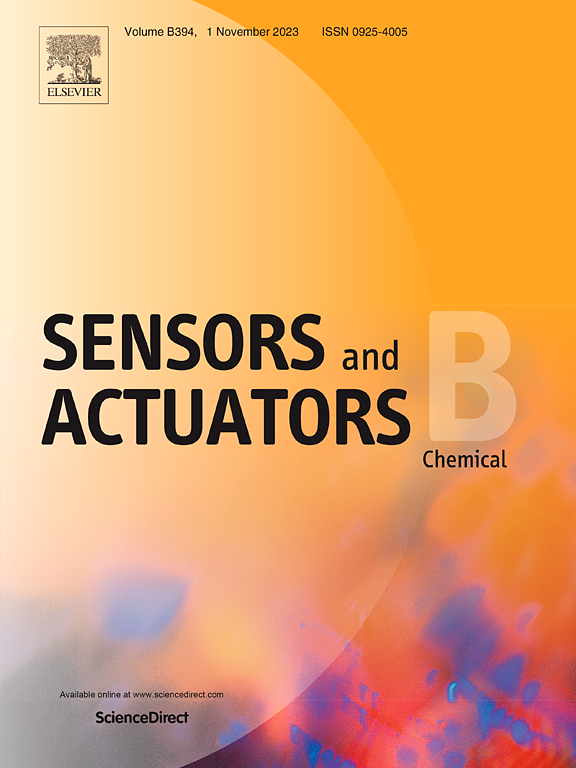碳纳米管/聚苯胺膜电极的亲水性和微观结构的同步调节确保了电化学离子致动器具有超长循环性能
IF 8
1区 化学
Q1 CHEMISTRY, ANALYTICAL
引用次数: 0
摘要
电化学离子致动器(ECIAs)是一种新型的软智能机器人技术,它可以通过电化学诱导离子迁移,有效地将电能转化为机械能。ecia的行为主要取决于电极的电化学存储容量,但电极的电化学不稳定性直接导致ecia的寿命较差。在此,我们通过在CNT薄膜上原位电聚合聚苯胺,成功地设计并制备了一种新型的柔性独立式碳纳米管/聚苯胺(CNT/PANI)薄膜,用于超长循环性能的ECIAs。与传统的碳纳米管或聚苯胺电极不同,所开发的碳纳米管/聚苯胺复合膜结合了碳纳米管的双电层电容和聚苯胺的赝电容,具有独特的协同效应。原位电聚合方法使聚苯胺在碳纳米管网络内均匀沉积,形成紧密结合的三维结构,增强了离子可及性和界面接触。CNT/PANI膜电极具有优异的亲水性和对离子液体的亲和力,增强了电极与电解质层之间的粘附性,有利于亲水性离子(EMI+和BF4-)的迁移。同时,原位电聚合聚苯胺材料可以提高碳纳米管/聚苯胺薄膜电极的离子存储能力,从而提高ecia的驱动能力。因此,基于A-CNT/PANI薄膜电极的ecia不仅具有优异的机电性能(应变0.97%,应力7.07 MPa),而且具有高达100,000次循环的超高循环稳定性。我们的研究结果展示了一种强大、灵活的电极设计,可以减轻假电容材料集成中的常见挑战,确保ecia的稳定性和卓越的长期性能。本文章由计算机程序翻译,如有差异,请以英文原文为准。

Synchronised regulation of the hydrophilicity and microstructure of CNT/PANI film electrodes ensure electrochemical ionic actuators with ultra-long cycle performance
Electrochemical ion actuators (ECIAs), a novel soft smart robotics technology, can effectively convert electrical energy into mechanical energy via electrochemically induced ion migration. The behaviors of ECIAs mainly depends on the electrochemical storage capacity of the electrodes, but the electrochemical instability of the electrodes directly result in poor lifetime of ECIAs. Herein, we successfully designed and prepared a novel flexible free-standing carbon nanotube/polyaniline (CNT/PANI) film via the in-situ electro-polymerization of PANI on CNT films for ultra-long cycle performance ECIAs. Unlike conventional CNT or PANI electrodes, the developed CNT/PANI composite film offers a unique synergistic effect combining the electric double-layer capacitance of CNTs and the pseudocapacitance of PANI. The in-situ electro-polymerization method enables uniform PANI deposition within the CNT network, forming a tightly bonded, three-dimensional structure with enhanced ion accessibility and interfacial contact. The CNT/PANI film electrodes have excellent hydrophilicity and affinity to ionic liquid, which enhances the adhesion between electrode and electrolyte layers and facilitates the migration of hydrophilic ions (EMI+ and BF4-). Meanwhile, the in-situ electropolymerized PANI materials can improve the ion storage capacity of the CNT/PANI film electrodes, which in turn enhances the actuation abilities of the ECIAs. Consequently, the ECIAs based on the A-CNT/PANI film electrodes not only perform excellent electromechanical performance (strain 0.97%, stress 7.07 MPa), but also give an ultra-high cycling stability of up to 100,000 cycles. Our findings demonstrate a robust, flexible electrode design that mitigates common challenges in the integration of pseudocapacitive materials, ensuring stability and superior long-term performance in ECIAs.
求助全文
通过发布文献求助,成功后即可免费获取论文全文。
去求助
来源期刊

Sensors and Actuators B: Chemical
工程技术-电化学
CiteScore
14.60
自引率
11.90%
发文量
1776
审稿时长
3.2 months
期刊介绍:
Sensors & Actuators, B: Chemical is an international journal focused on the research and development of chemical transducers. It covers chemical sensors and biosensors, chemical actuators, and analytical microsystems. The journal is interdisciplinary, aiming to publish original works showcasing substantial advancements beyond the current state of the art in these fields, with practical applicability to solving meaningful analytical problems. Review articles are accepted by invitation from an Editor of the journal.
 求助内容:
求助内容: 应助结果提醒方式:
应助结果提醒方式:


